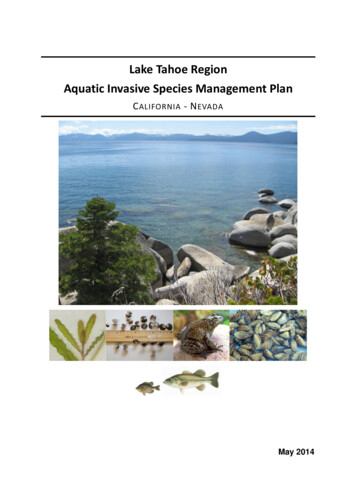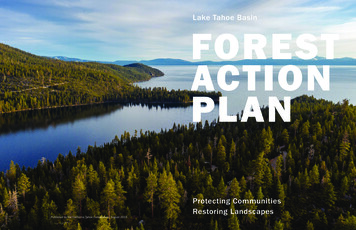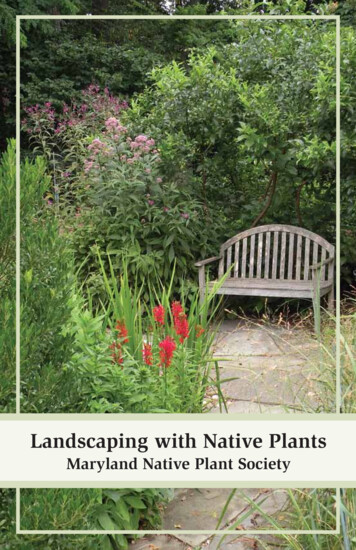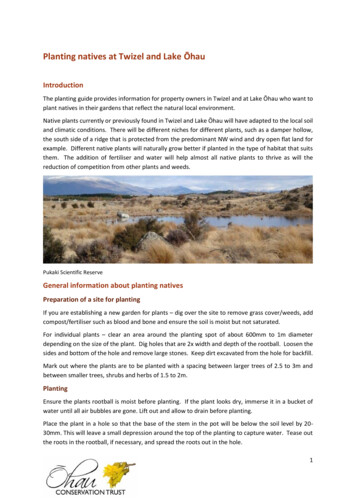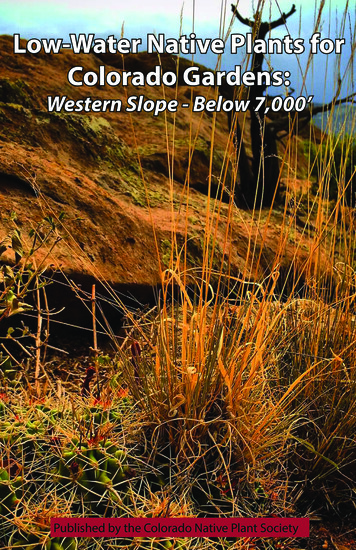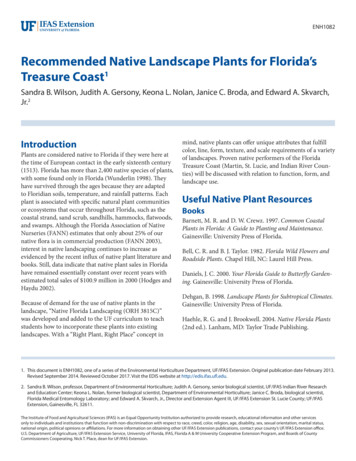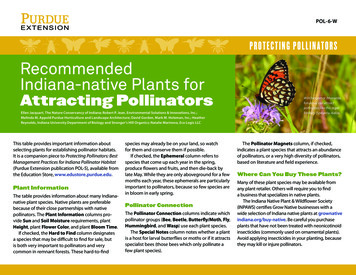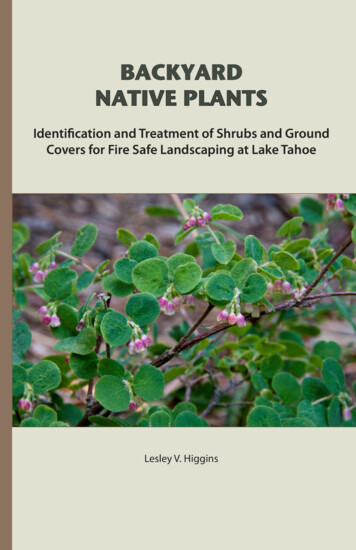
Transcription
BACKYARDNATIVE PLANTSIdentification and Treatment of Shrubs and GroundCovers for Fire Safe Landscaping at Lake TahoeLesley V. Higgins
2HOW THE TAHOE BASIN HAS CHANGEDFire was once a natural part of the Lake Tahoe ecosystem before theComstock logging era in the late 1800s. Many of Tahoe’s nativeplants evolved with periodic fire, which served to remove dead or diseased trees and shrubs, smaller trees, and the buildup of forest litter.Now that the forest has grown back without this limiting factor, it hasbecome overcrowded with too many trees competing for water andnutrients. This crowding affects overall tree health, reduces the diversity and abundance of other plants, and greatly increases the risk ofcatastrophic wildfire. Urbanization has also increased the fire hazardwith combustible structures in close proximity to high fire risk plants.WHAT CAN WE DO?To restore a healthy forest and protect our homes from fire, we canmimic fire’s historical effect by thinning and trimming the treesand shrubs ourselves. By doing so, we can also enhance the naturallandscape and improve the habitat for a greater variety of plants andanimals. Defensible space practices can be combined with landscaping goals to reduce wildfire risk while maintaining the qualities wevalue in our forest environment.This booklet helps homeowners identify and treat the most commonnative shrubs and ground covers on their property. It is meant to beused as companion to Fire Adapted Communities: The Next Step inWildfire Preparedness (Lake Tahoe Basin). For additional resourcesvisit tahoe.livingwithfire.info.The fire risk designations in this booklet have been reviewed by theTahoe Fire and Fuels Team in collaboration with the Tahoe Basin FireChiefs. Homeowners should contact their local fire agency for site specificguidance on defensible space.
Table of ContentsCreeping Snowberry6Thimbleberry7Woods’ Rose or Mountain Rose8Blue Elderberry9Sierra Gooseberry10Sierra Currant or Mountain Pink11Wax Currant12Western Serviceberry13Bittercherry14Mahala Mat15Pinemat Manzanita16Mountain Whitethorn17Tobacco Brush or Snowbrush18Bitterbrush19Bush Chinquapin or Sierra Chinquapin20Greenleaf Manzanita21Huckleberry Oak22Big Sagebrush23Rubber Rabbitbrush24Curlleaf Mountain Mahogany25Photography by Peter King
4TManaging Native Plants for Fire Safetyreatment and maintenance of native plantsfor fire defensible space depends on: Type of plantHeight and age of plantDensity and volume of plantDead material in plantProximity to structuresEvergreen trees and shrubs usually have higher fire risk than deciduous plants,which seasonally lose their leaves. A high density of leaves and stems alsoincreases fire hazard, which makes pruning shrubs an important part of yearlylandscape maintenance. Removal of old growth in shrubs can stimulate newgrowth, which typically has a higher moisture content and lower fire risk.Location relative to structures ultimately determines how different typesof plants should be treated. Consult Living with Fire and local fire agencypersonnel for specific details on how to treat plants next to structures.Defensible space considerationsContinuous plant cover can pose a higher fire risk. Keeping plants trimmed,separated, and free of pine needles is vitally important to reducing fire hazard.Living with Fire guidelines describe how to remove ladder fuels and separatehigh fire risk plants to prevent fire transmission. Contact the local fire agencyfor advice and an on-site defensible space inspection.There are various methods for disposal of plant material: chipping on site,hauling away, or burning. Consult the local fire agency for information on chipping programs and burn pile rules and requirements. Wood chips can be usedfor mulch on properties if they conform to the guidelines for defensible space.Many jurisdictions have pine needle drop-off or collection programs.Pruning shrubs - sprouters vs. non-sproutersMost evergreen shrubs are fire-adapted to resprout from the root crown after a fire, and canbe cut to the ground. However, some deciduousshrubs are non-sprouters and may not regenerateif cut to the ground. One method for maintainingdefensible space separation is to alternate cuttingManzanita shoots after fireadjacent high fire risk shrubs to the ground on a 3to 5 year cycle. This rotated pruning conserves plants while keeping fire risk low.Refer to the plant growth and maintenance sections for details on pruning.
Native Plants in an Integrated Landscape5Native plants provide forage, cover, andnesting sites for a variety of wildlife.They are excellent at anchoring the soil andpreventing sediment loss. As part of thenatural environment, native plants are critical in preserving a functioning Sierra Nevadaecosystem.Providing for wildlifeMule deer eating newtobacco brush shootsGolden-mantled ground squirrelenjoying tobacco brush berriesBerries and seeds are an important food sourcefor birds, mammals, and insects. New leavesand shoots are browsed by deer. Forage can beenhanced with periodicpruning to encourage newgrowth. Many animals usenative plants to hide theirnests and find shelter frompredators and the elements.Erosion control - best management practicesJunco with snowberryStabilizing soil on developed properties is important for preventing erosionand sediment runoff that reduces Lake Tahoe’s clarity. Tahoe’s native plantsnaturally anchor the soil with deep or spreading roots. Retain plants wherepossible while using defensible space guidelines in Living with Fire. Steep slopesespecially benefit from soil stabilizing plants, but spacing of high fire risk plantsneeds to increase as slopes steepen. When removing plants, keep roots in placeto stabilize soil unless replacing with another plant.Planting and maintaining native plantsThe information in this booklet is intended for existing native plants. It can alsobe used for choosing plants for your property depending on defensible spacerequirements, moisture needs and growth characteristics. Most of the deciduous plants in this booklet are available in local nurseries. After planting, regularwatering is needed for the first 3-5 years for roots to become established. TheHome Landscaping Guide has information on drip irrigation systems.Native plants are adapted for dry summers and snowy winters. During droughtyears, however, deciduous plants can benefit from infrequent deep watering.Except for small trees, native plants do not need to be tied up to protect themfrom snow loading. Although fertilizer use is unnecessary, a small amount ofslow releasing organic fertilizer can promote growth.
6Creeping SnowberrySymphoricarpos mollisDescription: Low fire riskDeciduous shrubby ground cover, 6 inchesto 2 feet high with round pale green leaves.Vine-like branches trail 3-6 feet; new growthis pink. Small pinkish flowers form clusters ofwhite berries. Yellow fall color.Growth characteristics:Grows well in mediummoisture areas, in sunto part shade. Rapidgrowth rate. Works wellfor erosion control.Maintenance:Very little maintenance needed, except tokeep free of pine needles and debris. Pineneedle removal can be difficult due to rootingbranches. Pruning can encourage morebranching. Spreads with or without watering.
Thimbleberry7Rubus parviflorusDescription: Low fire riskDeciduous ground cover 1-2 feet high.Large, soft, maple-like, bright greenleaves on erect stems with 5 toothedlobes. Large white flowers produce redberries. Yellow fall color.Growth characteristics:Grows well in medium-wet areas, in partshade. It can grow in open, drier sites,but is usually associated with willows, firand aspen. Rapid to moderate growthrate. Can form dense thickets, usuallyspreading from underground stems.Maintenance:Little maintenance needed except to keep free of pine needles and debris.Remove dried leaves in the fall to reduce fire risk. Water during drought or toencourage spreading. This plant is easily damaged and should not be walkedon or disturbed.
8Woods’ Rose or Mountain RoseRosa woodsii var. UltramontanaDescription: Low fire riskDeciduous shrub with multiple thorny stems 2-7feet high. Leaves have 5-7 oval leaflets with serrated edges. Simple white to pink flowers have5 petals and produce a dark red rose hip. Leavesturn red-orange in the fall.Growth characteristics:Grows well in semi-moist areas in forest openings, in sun or part shade. Has a rapid growthrate and spreads from suckering roots, especiallywith extra watering. Can form dense thickets.Maintenance:Keep free of pine needles anddebris. Prune to remove deadand damaged stems or toencourage branching. Waterduring drought or to encourage growth.
Blue ElderberrySambucus ceruleaDescription: Low fire riskLarge deciduous shrub 5-10 feet high. Darkgreen opposing leaflets are serrated. Flatclusters of tiny white flowers produce darkblue berries which can have a white coating.Leaves turn yellow in the fall.Growth characteristics:Grows well in semi-moist open areas, sun orpart shade. Rapid growth rate. Herbaceousgrowth dies back to the ground every winter,although some woody stems may persist. Willregenerate if cut to the ground or burned.Maintenance:Prune in spring to remove dead and damaged woodystems. Keep free of pine needles and debris and rakeup dropped leaves in the fall. Remove woody stemsto reduce size next to structures. Water duringdrought or to encourage growth.9
10Sierra GooseberryRibes roezliiDescription: Low fire riskSmall deciduous shrub 1-3 feet high withspiny, long branching stems and lobed,toothed leaves. Red-purple, lantern-likeflowers hang down under the stems, andproduce distinctive round, spiny red fruits.Leaves turn red in the fall.Growth characteristics:Found in drier, often disturbed areas, in sunor part shade. Moderate growth rate. Goodfor slope stabilization. Will regenerate if cutto the ground or burned.Maintenance:Keep free of pine needles and debris. Prune toremove dead and damaged stems, or to encouragebranching. If next to structures, consult with localfire agency for recommendations. Watering notneeded.
Sierra Currant or Mountain PinkRibes nevadenseDescription: Low fire riskDeciduous shrub 3-6 feet high withrounded three-lobed leaves. Smooth,gray, erect branches. Drooping pink toreddish flower clusters produce dark blueberries. Leaves turn yellow in the fall.Growth characteristics:Grows well in forest margins in mediumto wet areas with partial shade. Moderategrowth rate. May not regenerate if cut tothe ground.Maintenance:Prune in spring to remove dead and broken branches.Keep free of pine needles and debris and rake updropped leaves in the fall. If next to structures, consultwith local fire agency for recommendations. Can bethinned or shaped. Water during drought or to encourage growth.11
12Wax CurrantRibes cereumDescription: Low fire riskDeciduous shrub grows 2-7 feet high. Small,lobed leaves have a glossy sheen on the uppersurface. Clusters of 3-7 tubular white to pinkflowers hang downwards and produce redberries. Leaves turn yellow in the fall.Growth characteristics:Grows well in dry open forest areas or rockyslopes, in sun or part shade. Moderate growthrate. A weak sprouter which may not re-generate if cut to the ground. Becomes leggy withover-watering.Maintenance: Limit next to structuresKeep free of pine needles and debris and rake updropped leaves in the fall. Prune to remove deadand damaged stems, or to encourage branching.Reduce numbers and size next to structures tolower fire risk. Watering not recommended.
Western ServiceberryAmelanchier alnifoliaDescription: Low fire riskLarge deciduous shrub 3-12 feet high. Rounddark green leaves are serrated at the ends.Reddish brown to grey branches. White5-petaled flower clusters produce bluish blackberries. Leaves turn yellow in the fall.Growth characteristics:Grows well in medium-dry areas, sun or partshade. Rapid growth rate. Forms thickets inmoist areas and can also grow into a manybranched small tree. Will regenerate if cut tothe ground or burned.Maintenance: Limit next to structuresPrune in spring to remove dead and damagedbranches and to reshape. Reduce numbers and sizenext to structures to lower fire risk. Keep free of pineneedles and rake up dropped leaves in the fall. Watering not recommended except during drought.13
14BittercherryPrunus emarginataDescription: Low fire riskLarge deciduous shrub with grayish bark, 4-12feet high. Oblong leaves are usually foldedlengthwise with slightly serrated edges.White 5-petaled flowers bloom in clusters andproduce a bitter red fruit. Leaves turn yellowin the fall.Growth characteristics:Grows well in medium to moist areas andalong stream banks, in sun or part shade.Often forms dense thickets, sprouting fromspreading roots. Moderate growth rate. Willregenerate if cut to the ground or burned.Maintenance: Limit next to structuresPrune out dead and damaged branches. Reducenumbers and size next to structures to lower fire risk.Keep free of pine needles and rake up leaves in the fall.Watering not recommended except during drought.
Mahala Mat15Ceanothus prostratusDescription: Low fire riskEvergreen ground cover with widely spreading branches form dense mats 2-5 inches high.Holly shaped dark green leaves with toothedmargins. Deep blue to light lavender flowerclusters. Fruit is a small brown round capsule.Growth characteristics:Stabilizes forest floor with mat-like rootingbranches. Grows well in medium to dry areas,sun or part shade. Slow growth rate. Difficultto establish.Maintenance: Limit next to structuresThis plant can retain highly flammable materialsuch as pine needles which should be regularly removed to keep fire risk low.May not be recommended directly adjacent to structures. Breaking up continuous cover next to structures will discourage fire spread in extreme conditions.Does not tolerate much foot traffic. Watering not recommended, except infrequently during drought or to encourage spreading.
16Pinemat ManzanitaArctostaphylos nevadensisDescription: Low to Moderate fire riskShrubby evergreen ground cover, withflat spreading reddish brown branches, 6inches to 2 feet high. Small elliptical leathery shiny leaves. White urn shaped flowerclusters form a brown berry-like fruit.Growth characteristics:Stabilizes forest floor with rooting branches.Grows well in dry areas with sandy soiland full sun. Slow growth rate. May notresprout if cut to the ground.Maintenance: Limit near structuresMay require extra maintenance to keep fire risk low as this plant can easily retainhighly flammable material such as pine needles and fallen branches. Regularlyremove debris and prune out dead branches. Keep low to the ground and breakup large areas to reduce continuity and possible fire spread. Treat as individualspecimen plants next to structures. Pinching off new spring growth can encourage branching. Watering not recommended.
Mountain Whitethorn17Ceanothus cordulatusDescription: Moderate to high fire riskFlat topped, spreading evergreen shrub, 2-4feet high and 3-10 feet wide. Whitish rigidbranches have small gray-green oval leavesand 1-11/2 inch thorns. Tiny white to yellowflower clusters. Can hybridize with tobaccobrush to produce an intermediate form.Growth characteristics:Grows well in semi-dry open areas, full sun topart shade. Rapid growth after pruning. Willregenerate if cut to the ground. Can form vastthickets after logging or burning. Good forslope stabilization.Maintenance: Keep away from structuresReduce and separate into individual plants according to defensible spaceguidelines. Remove dead branches and keep free of pine needles and debris.Responds well to pruning; can be thinned or shaped to keep low to ground.Watering not recommended.
18Tobacco Brush or SnowbrushCeanothus velutinusDescription: High fire riskA spreading, thicket forming evergreen shrub, 3-6feet high. Glossy green leaves with three prominent veins underneath. The ends of the reddishbrown branches support showy clusters of tinywhite flowers. Can hybridize with mountainwhitethorn. Leaves fold up lengthwise in winter.Growth characteristics:Grows well in dry open areas with full sun. Slowto moderate growth rate when mature. Willnot regrow from cut bare stems, but will sproutrapidly if cut to the ground. Can form vast thickets in logged or burned areas. Becomes leggyand degraded with age.Maintenance: Keep away from structuresReduce and separate individual plants according to defensible space guidelines.Cut old growth to the ground to keep plant low and healthy. Keep free of pineneedles and dead branches. Watering not recommended.
Bitterbrush19Purshia tridentataDescription: High fire riskA mostly deciduous shrub 2-5 feet high withbranches usually originating at base of plant.Small, wedge-shaped, gray to dark green 3lobed leaves (some are persistent in winter).Yellow flowers with 5 petals.Growth characteristics:Grows well in dry, well drained areas in full sunto part shade. Growth form varies from low tothe ground to upright. Moderate growth rate.May not regenerate if cut to the ground. Canwork well for slope stabilization.Maintenance:Keep away from structuresReduce and separate individual plants according to defensible space guidelines. Keep free of pine needles and dead branches. Can be selectively prunedby maintaining viable buds on cut branches. Watering not recommended.
20Bush Chinquapin or Sierra ChinquapinChrysolepis sempervirensDescription: High fire riskEvergreen shrub 2-5 feet high, with smoothgrayish brown bark. The long leathery greenleaves are tan or lighter green underneath.Whitish flowers are arranged on a stalk andproduce large round spiny fruits. May haveround red or yellow wasp galls. Can be confused with huckleberry oak.Growth characteristics:Grows well in medium moisture to dry areas infull sun or part shade. Slow growth rate. Willregenerate slowly if cut to the ground. Becomesleggy and degraded with age.Maintenance: Keep away from structuresReduce and separate individual plants accordingto defensible space guidelines. Keep free of pineneedles, debris and dead branches. Wateringnot recommended.
Greenleaf ManzanitaArctostaphylos patulaDescription: High fire riskEvergreen shrub with reddish brown rigidbranches, 3-5 feet high. Round bright greenleathery leaves with smooth edges. Clustersof urn shaped flowers range from white to pinkand form dark brown apple shaped fruits. Someleaves turn yellow and drop off in the fall.Growth characteristics:Grows well in dry areas in full sun. Slow growing.Whole branches can die off under adverse conditions such as too much water or shade. Willregenerate if cut to the ground or burned.Maintenance: Keep away from structuresReduce and separate individual plants according todefensible space guidelines. Keep free of pine needlesand dead branches. Can be pruned into an open shapewith branches exposed to decrease density. Wateringnot recommended.21
22Huckleberry OakQuercus vaccinifoliaDescription: High fire riskEvergreen spreading shrub 1-6 feet high.Smooth gray branches have small, stiff leaveswith smooth or serrated edges. Brown catkinsoccasionally produce acorns. May have papergalls. Can be confused with bush chinquapin.Growth characteristics:Grows well in medium moisture to dry areas infull sun to part shade. Slow to moderate growthrate. Will regenerate slowly if cut to the ground.Declines with over-watering. Good for slope stabilization.Maintenance: Keep away from structuresReduce and separate individual plants accordingto defensible space guidelines. Keep free of deadbranches, debris, and pine needles. Can be shapedand kept low to the ground by pruning. Watering notrecommended.
Big SagebrushArtemisia tridentataDescription: High fire riskErect rounded evergreen shrub 1-4 feet highwith branches originating from a short trunk.Dense growth of aromatic silvery 3 lobedleaves contain volatile oils. Tall erect silverstems produce tiny yellowish flowers in latesummer with tan seeds in the fall.Growth characteristics:Grows well in dry, well drained areas in full sunto part shade. Moderate to rapid growth rate.Will not regenerate if cut to the ground.Maintenance: Keep away from structuresReduce and separate individual plants accordingto defensible space guidelines. Keep free of deadbranches, debris, and pine needles. May not respondwell to pruning. Watering not recommended.23
24Rubber RabbitbrushChrysothamnus nauseosusDescription: High fire riskA widely distributed deciduous shrub 1-3feet high. The upright branches have aromatic silvery green leaves that are long andnarrow. Clusters of small, 5-petaled yellowflowers bloom in late summer.Growth characteristics:Grows well in dry open areas in full sun andon disturbed sites. Moderate growth rate.Sprouts from the stems and root crown.Good for revegetation and soil stabilization.Maintenance: Keep away from structuresReduce and separate individual plants according to defensible space guidelines. Can be pruned to remove old growth and encourage branching. Shouldresprout if cut to the ground. Keep free of pine needles and debris. Wateringnot recommended.
Curlleaf Mountain Mahogany25Cercocarpus ledifoliusDescription: High fire riskA large evergreen shrub, or small tree,6-12 feet high. The numerous brancheshave small oblong leathery leaves that curlunder. Inconspicuous flowers produceseeds with long tails in late summer.Growth characteristics:Grows well in dry rocky slopes in full sun.Long-lived with low to moderate growthrate. Has a shallow root system whichusually does not sprout after cutting orburning.Maintenance: Keep away from structuresReduce and separate individual plants according to defensible space guidelines.Prune to remove dead branches or create a tree-like form. Probably will notregenerate if cut to the ground. Keep free of pine needles and debris. Wateringnot recommended.
26Help and InformationThere are many agencies in the Tahoe Basin which are ready to help homeowners. Listed below are some that provide resources and expertise withdefensible space, general landscape management, and conservation practices.Contact information is available online at tahoe.livingwithfire.info, and in FireAdapted Communities: The Next Step in Wildfire Preparedness (Lake Tahoe Basin)or the Home Landscaping Guide for Lake Tahoe and Vicinity.Fire Protection Agencies: Local firedistricts and departments provide defensible space inspections, tree removal permits,chipping services, and advice on how toreduce fire threat and protect homesand property from wildfire.Visit tahoe.livingwithfire.info to find yourfire district.The Tahoe Network of Fire Adapted Communities:The TahoeNetwork of Fire Adapted Communities is an alliance of organizationsworking to reduce wildfire risk in the Lake Tahoe Basin. It is made up of theTahoe Resource Conservation District, fire protection districts, landmanagement agencies, and engaged communities. The Network focuses onconnecting residents and fire protection districts, and empoweringcommunities to prepare for wildfire.Conservation Districts: BackyardConservation programs include best management practices (BMPs), invasive weedcontrol, water and fertilizer management,native plants and habitat enhancement.Contact the Nevada Tahoe ConservationDistrict (ntcd.org) or the Tahoe ResourceConservation District (tahoercd.org) forresources.University Cooperative Extension:The University of NevadaCooperative Extension provides educational materials, including the HomeLandscaping Guide, Fire Adapted Communities, and other information forresidents of Lake Tahoe. The University of California Cooperative Extension,with an office in South Shore, has many publications and resources on fire safeconstruction and home landscaping for fire.
27Selected ReferencesCobourn, J., B. Carlos, J. Christopherson, W. Johnson, R. Post, J. Skelley andE. Smith. 2006. Home Landscaping Guide for Lake Tahoe and Vicinity.University of Nevada Cooperative Extension EducationalBulletin-06-01. Reno, NV.Compston, M., E. Smith and L. Huntsinger. 1998. Common Lake Tahoe BasinPlants: Descriptions, Values and Fire Effects. University of NevadaCooperative Extension. Reno, NV.Fire Effects Information System. 2008. www.fs.fed.us/database/feis/plants/shrub. USDA Forest Service, Intermountain Research Station, FireScience Laboratory. Missoula, MT.Graf, M. 1999. Plants of the Tahoe Basin: Flowering Plants, Trees and Ferns.University of California Press. Berkeley, CA.Johnson, W. and J. Christopherson. 1992. Shrubs for Tahoe Landscapes.University of Nevada Cooperative Extension Fact Sheet 82-48.Reno, NV.Laws, J. M. 2007. The Laws Field Guide to the Sierra Nevada. CaliforniaAcademy of Sciences. Hayday Books. Berkeley, CASmith, E. and S. Sistare, 2014. Fire Adapted Communities: The NextStep in WIldfire Preparedness (Lake Tahoe Basin). University ofNevada Cooperative Extension Special Pub.-14-05. Reno, NV.AcknowledgementsMany thanks and appreciation to the following people for their valuable helpand advice: Ed Smith, Norb Szczurek, John Cobourn, Peter King, Jerry Owens,Tia Rancourt, the Tahoe Basin Fire Chiefs and their representatives, and theParasol Tahoe Community Foundation which provided most of the funding.About the AuthorLesley Higgins has a Ph.D. in Biology from the University of California at SantaCruz. She has worked in the Tahoe Basin with best management practices,defensible space, and native plants to promote forest health and conservation.
Supported and Funded by:Parasol Tahoe Community FoundationCalifornia Department of Forestry andFire ProtectionTahoe Regional Planning AgencyNevada Tahoe Conservation DistrictTahoe Resource Conservation DistrictTahoe Fire and Fuels TeamA Tahoe Conservation Services Publication 2009 Lesley V. Higginsrev 081018
HOW THE TAHOE BASIN HAS CHANGED. F. ire was once a natural part of the Lake Tahoe ecosystem before the Comstock logging era in the late 1800s. Many of Tahoe's native plants evolved with periodic fire, which served to remove dead or dis-eased trees and shrubs, smaller trees, and the buildup of forest litter.



